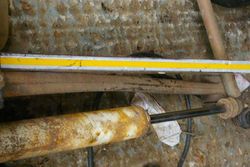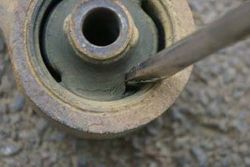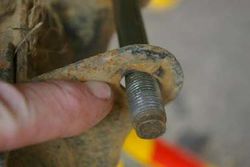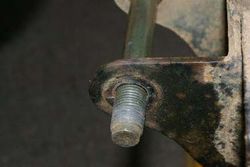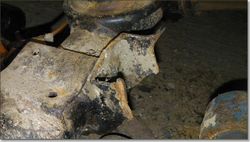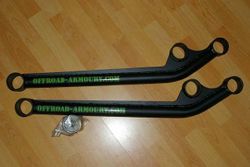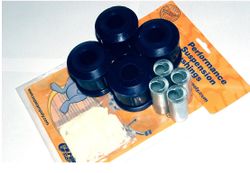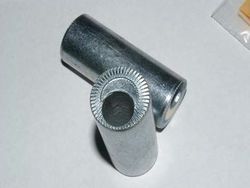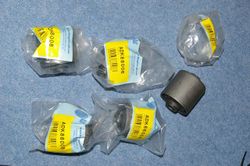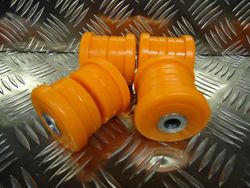Difference between revisions of "Martins Test"
| Line 87: | Line 87: | ||
NOTE: Suzuki have identified that the 46213-65D series of bushes can cause [[Death_Wobble |Death Wobble]] a kit to replace these exists [https://www.bigjimny.com/store/suzuki-jimny-wobble-kit.html Wobble Kit] | NOTE: Suzuki have identified that the 46213-65D series of bushes can cause [[Death_Wobble |Death Wobble]] a kit to replace these exists [https://www.bigjimny.com/store/suzuki-jimny-wobble-kit.html Wobble Kit] | ||
| + | |||
| + | A number of after-market suppliers also supply replacement bushes. These are commonly called "Poly-Bush" style and usually come in the form of a split bush which can be more easily inserted in the arms. For example here are some from [http://www.bits4vits.co.uk/store/jimny/radius-arm-to-axle-bushes-bits4vits/prod_1010.html Dave at Bits4Vits] | ||
| + | |||
| + | [[image:B4v-jimBshRAA.jpg|250px|thumb|left|Bits4Vits bushes]] | ||
| + | <br clear=all> | ||
| + | |||
If you are going to the trouble of putting on new arms you really ought to put in new bushes as they do wear and they are difficult to press out of the old arms anyway. | If you are going to the trouble of putting on new arms you really ought to put in new bushes as they do wear and they are difficult to press out of the old arms anyway. | ||
Revision as of 08:37, 3 June 2016
Contents
Arms and Bushes
The Leading/Trailing Arms (or Radius Arms) on a Jimny are prone to off-roading or accident damage whilst the bushes are prone to wear. The arms also control the castor angle of the front axle and the diff angle of the rear axle. This section covers the changing of the arms, bushes and repair of general damage.
Typical Damage
Damaged Arms
My arms had suffered from a number of years of off-roading, they were also fitted with correction bushes which are good for a 2 inch lift but not really ok for the 3 inch lift I have got fitted.
The arms on mine were nicely bent when compared to the edge of my yellow spirit level.....
Therefore I decided to replace the arms and cure the castor correction issues at the same time. A number of places do suitable replacement arms, be very careful about what arms you buy as the quality varies and any failure of the arm is very dangerous. The process for installation of fronts and rears is basically the same.
Damaged Bushes
Worn bushes can be a source of "Death Wobble". Here bushes themselves are splitting. Whilst they had not completely failed they were not in good health. You can see where the screwdriver can open up the split in the pictures below:
Damaged Mounts
The mounting points for the arms are really weak and thin. They can wear out in an "oval" fashion that results in a strange "clunk" noise when letting the clutch up. In the worst case the mount can corrode through and rip away from the axle, this is becoming increasingly common as Jimnys get older.
This is the same part as shown in the previous pictures except it is completely ripped off and gone!
Castor Correction
If you are performing a lift then you may have heard about castor correction. The process of a spring lift (NOT a body lift) moves the position and angle of the axle slightly. This shows itself in the steering by making the steering feel loose and also reduces its ability to self centre. You can test this by steering in a gentle circle and then letting go of the steering wheel. A properly corrected Jimny will straighten up on its own whilst an uncorrected one will keep turning.
There are a number of ways of correcting the castor.
Correction Arms
The picture shows the arms for the front along with a free bush insertion tool with the ones I purchased.
These arms are made with the adjustment built in therefore they should be fitted with STANDARD bushes. They are typically available for 3 inch or 4 inch lifts. Most people feel that 2 inch lifts do not need correction.
Correction Bushes
These work by off-setting the centre of the mount to achieve the correction. They are popular because of the price however they are probably best for small lifts (2 inches up to possibly 3 inches at a push) because the off-set required to give a larger lift means there is little to no rubber on one side of the bush which really affects its performance and ride).
Standard Bushes
A number of standard bushes are available.
The parts are ALL available by contacting the BigJimny store via phone or email (these are not stock items so are not shown directly in the store)
- ADK 88008 - Axle end bushes (Four required)
- ADK 88007 - Body end bushes (Two required)
If you are doing the back then the part numbers are:
- ADK 88006 - Axle end bushes (Four required)
- ADK 88007 - Body end bushes (Two required)
You could also buy the Suzuki ones if you want the original parts, the part numbers for the front are:
- 46282-81A1 - Axle end bushes (Four required)
- 46213-65D01 - Body end bushes (Two required)
And the rear are:
- 46282-81A00 - Axle end bushes (Four required)
- 46213-65D01 - Body end bushes (Two required) (See Note)
NOTE: Suzuki have identified that the 46213-65D series of bushes can cause Death Wobble a kit to replace these exists Wobble Kit
A number of after-market suppliers also supply replacement bushes. These are commonly called "Poly-Bush" style and usually come in the form of a split bush which can be more easily inserted in the arms. For example here are some from Dave at Bits4Vits
If you are going to the trouble of putting on new arms you really ought to put in new bushes as they do wear and they are difficult to press out of the old arms anyway.
Replacing the Bushes and Arms
So onwards to installing the arms
- The first activity is to remove the old arms. You need to jack up the car and remove the front wheel. I assume you can do that so have not included it here. PLEASE NOTE: You will have to jack up the car WITHOUT using the axle or leading arm as a jacking point, you need the axle to be free to be unbolted from the arm.
- The arm is secured with three bolts, one at the back and two at the front. You may have to cut the old bolts off as they could be rusted on. Those of you with older Jimnys may have the vacuum tubes for the locking hubs routed down the arms. The latest ORA arms have suitable mounting points for the tubes so as part of this process you will have to move the tubes from the old arms across to the new ones. This is not shown in this write-up as my Jimny does not have the tubes routed this way.
- You will need to press in the bushes, I have played about with trying to "wind" the new ones in with a piece of threaded rod but this was not successful. It would probably work with Polybush style bushes (SuperPro) as these are not encased in a metal casing like Suzuki or ADK bushes. You should be able to find a local garage or engineering shop prepared to press them in for a small consideration. However, as I have worn a bit thin my welcome at my local garages with pressing in wheel bearings I decided to splash out on my own press. I am glad I did because of the time it took to press in the six bushes would have definitely seem me less than welcome at the garage.
- The picture below show the principle behind pressing in the bush. The outer ring from the Off-Road Armory tool is placed over the hole and the bush is dropped in (with a smear of copper grease to help everything along)
Figure 4. Bush tool in place
- Then the centre part of the tool is placed on top of the bush and the pressure is applied using the press, driving the bush into the arm.
Figure 5. Pressing in the Bush
- Resulting in a bush neatly pressed into the arm.
Figure 6. Complete Bush
- However, it did not all go as smoothly as this for all the bushes. Whilst the outer part of the tool is a good fit, the inner part is right on the edge between sitting on the lip of the bush and dropping into the inner part where the rubber is. It is just a fraction too small. This applies to both ADK and Suzuki bushes as I have a mix of both on my car due to ADK running out. NOTE: Rob from the Off-Road Armory has told me that a revised tool is now sent out with the full arm kit so things have changed since I built my arms, therefore this write-up reflects how it went for me with the old tooling. The Off-Road Armory also offer to supply the arms with the bushes already installing (at extra cost).
- The problem is slightly worse on the body end bushes as these are longer and stand proud of the tool. This means the tool/bush can move off of "straight" and result in damage to the bush. I had to clean up the damaged bush with a file to get rid of the edges that stood proud and would stop the bush fitting.
Figure 7. Damaged Bush
- The cure to this for the longer bushes was to stop using the tool and simply use a large flat surface to press on top of the bush. The pressing surface has to have a hole in it to allow the bush centre to stand proud, an old flange from my SJ did the trick.
- I also created a very light chamfer on the edge of the arm with a file to "point" the bush in the correct direction. The first picture shows the chamfer....
Figure 8. Chamfering the edge of the arm
- Then the SJ flange pushed the bush in fair and square.
Figure 9. Using an SJ Flange to press in the bush
- So I ended up with a smart pair of arms complete with bushes....
Figure 10. Finished arms
- The next challenge is to fit the arms back onto the car. Because mine is a full rebuild, everything has been off the car and hence has "moved". If you were doing this as an upgrade your more likely to remove one arm at a time, keeping most parts in line. I had to line everything up to get the bolts in.
- I would recommend that you hang the arm from the body end first...
Figure 11. Body end fitted first
- I replaced all the bolts and nuts (M12 x 88mm x 1.25 Metric Fine) as the old ones had to be cut out.
- I would recommend AHC in Camberley for the bolts (but note that their website does not list them, but they hold a good stock of various lengths) or Namrick are also a good online option. Just a further word on the bolts/nuts. They can be fitted through in either direction but if they are too long or fitted the wrong way around (which is possible if you have removed the shock absorber) then you will find they foul on the shock absorber. Play about with the bolt arrangements BEFORE tightening them or you may have to take them out again, guess how I learnt that!
- With the rear of the arm attached I then offered up the front arms to the mounting point on the axle. This was a long way off so I used a Jack to lift the arm into position and then a lever (ok - I admit it - a large screwdriver!) to move it all around until the bolts fitted.
Figure 12. Front end bolts
- The bolts should be tightened to 90Nm or 65 lb-ft.
Variations on a theme
- The Offroad Armory continually develops its products. Therefore since this was written the arms have mounting points for the vacuum tubes on early models and the pressing tool has changed. I would recommend you discuss your needs with Rob at Off-Road Armory and he will be able to take you through the options they sell and any new developments.
Page last edited on 3/06/2016 by user Mlines
